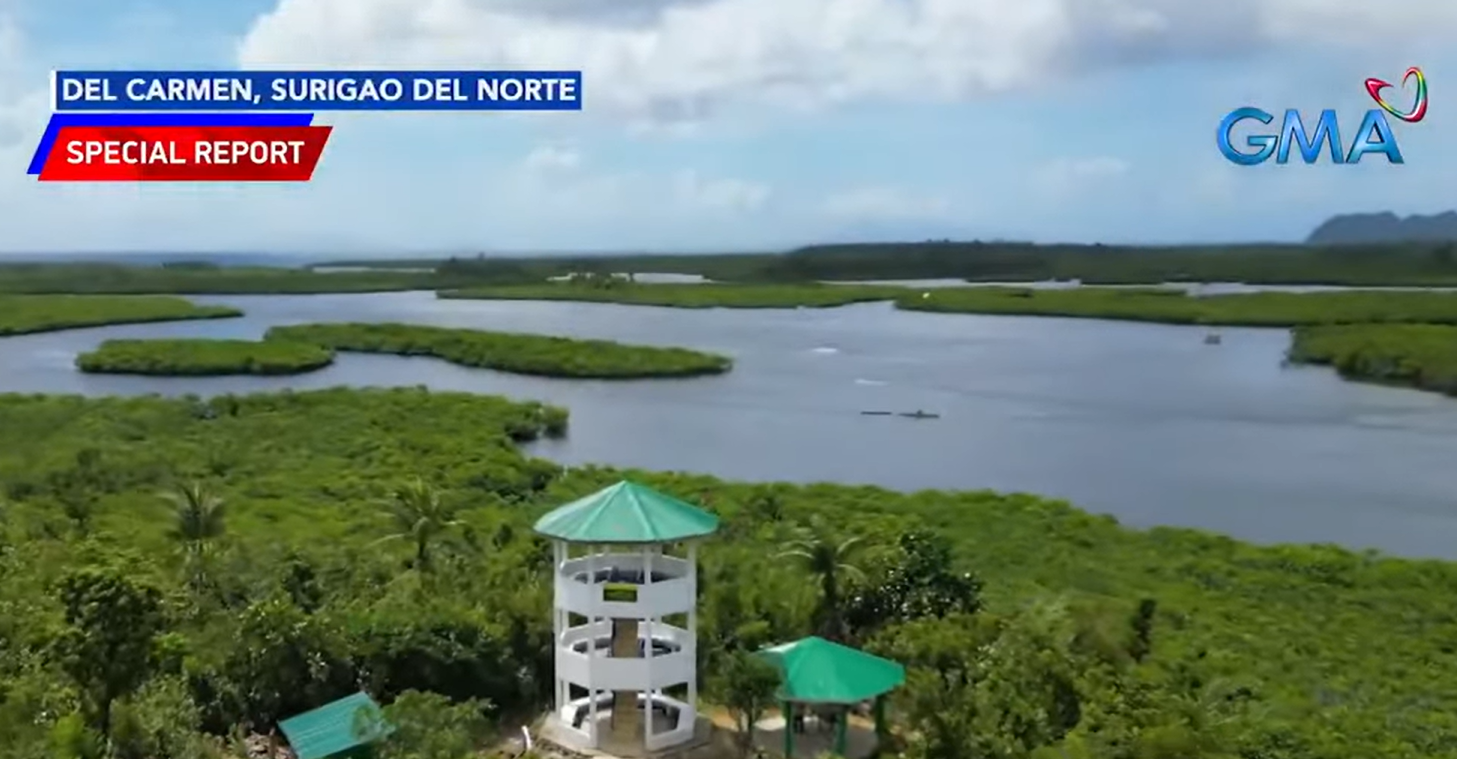Since he was 15, Junrey Longos has lived among lush mangrove forests and turquoise waters in Del Carmen, his hometown in the Philippines' surfing capital on Siargao Island. Once an illegal fisher who would cut the woody tropical trees to be sold as fuel, he now protects them as part of a civilian fisheries patrol force. "Because life was difficult, we were forced to cut and sell mangroves back then.
We couldn't find other jobs," Longos, 44, said. But with efforts by the local government to offer job training and nurture an ecotourism business, workers like Longos became part of the solution, not the problem. "I started planting new mangroves when I stopped doing illegal activities in 2011," he said, proudly pointing out a baby mangrove he helped plant along the water.

For decades, the area's mangrove cover was reduced by destructive fishing methods like the use of dynamite and illegal deforestation for wood to bake bread or make charcoal. Through replanting efforts, the Del Carmen Mangrove Reserve grew from 4,200 hectares of mangroves in 2012 to now more than 4,800 hectares, according to the local government. The reserve was designated in August 2024 as a wetland of international importance under the Ramsar Convention on Wetlands, an international treaty named after the city in Iran where it was signed in 1971, that guides the conservation of wetlands around the world.
Nowadays, Longos climbs the reserve's viewing deck to patrol against illegal fishers and cutters, for which he is paid an honorarium of 9,000 ($158) pesos monthly. In his free time, he uses his fishing boat for paid tours around the mangrove reserve. Del Carmen Mayor Alfred Coro said the stories of town fishers like Longos show that even small communities lacking resources can help stop environmental destruction.
He said this requires gaining people's support through education and ecotourism training and opportunities instead of policing. "For the longest time, past leaders in Del Carmen were told that it was impossible to convince people to stop illegal mangrove cutting and illegal fishing," said Coro. He said it took them a decade to convince people to abandon illegal practices and appreciate mangroves.
Strapped of financial resources, he said the effort was done largely through house-to-house dialogues with fishers and community-based information campaigns about mangrove protection. The tours were started by the local government, which now runs them with fishers' groups. Fishers earn a portion of the tour fee, or about 400 pesos ($6.
99) per trip. With the Ramsar recognition as of last year, however, the town is bracing for tourism growth and development. More than half a million tourists visited Siargao in 2023 — the highest on record, surpassing pre-pandemic levels, drawn to its impressive waves and surfing spots since the sport started catching on in the 1980s.
Sustainable tourism Some researchers fear more visitors could strain Siargao's natural resources and present waste problems, such as marine debris and plastic pollution. Research by the Asian Development Bank noted that the increase in Siargao’s waste "is attributable to the surge of tourist arrivals". The study suggested sustainable tourism, such as implementing a sound waste management system, could protect marine life as well as support the incomes of locals who remain dependent on the sea.
The municipality of Del Carmen has encouraged residents to earn money from ecotours and to care for mangroves so that tourism can support the community over the long term. Fishers like Longos were taught the science behind mangroves and encouraged to join replanting and campaigns for mangrove protection. "When we started, .
.. they had doubts," said Coro.
Hundreds of former illegal fishers and mangrove cutters became tourism operators since the effort began in 2014, and the town now offers some 100 ecotrips per day, according to a local tourism officer. Such tours employ guides, boat pilots and assistants. "You can see how their lives improved," said Coro.
The mayor said developing an alternative income source has had ripple effects to the local economy. From being a fifth-class municipality — a type of town with the lowest income in the Philippines — Del Carmen became a third-class municipality this year. The average family income in Del Carmen grew from 2,000 pesos ($34.
95) a month in 2010 to 17,000 pesos ($297.05) in 2024, while poverty incidence dropped from 69% in 2010 to 21% last year, local government data showed. The town’s income from tours grew from 1.
2 million pesos ($21,000) in 2020 to 9.2 million pesos ($160,381) in 2024. By fishing legally and conducting ecotours, Longos said he was able to send his four children to school.
Gina Barquilla, environmental officer of Del Carmen, said ecotours also prevent overfishing that may destroy mangrove habitats because income from tours encouraged people to spend less time catching fish. A task for the community In Siargao, a tear-drop shaped island, mangroves helped protect the region from a strong typhoon in 2021, lessening the impact of the powerful waves and rising sea level on coastal fishing villages, said Barquilla. For more than a decade, she has made home visits to educate illegal fishers and mangrove cutters and chased dynamite fishers at sea despite threats of legal and physical harassment.
There have been rare instances, like one in February, when fishers were arrested for using dynamite to kill schools of fish. "The most effective strategy was going to the communities and making them understand the science behind mangroves and conservation," she said. Generations of families have lived off money from mangrove cutting, so educating young people is key, she and other ecotourism advocates said.
Protecting mangroves “is all part of the life cycle that we have, what mangroves can do for us and what our lives can do for the mangroves,” Coro said. —Thomson Reuters Foundation/Reuters.
Technology

Siargao revives mangroves through ecotourism

Through replanting efforts, the Del Carmen Mangrove Reserve on Siargao Island grew from 4,200 hectares of mangroves in 2012 to now more than 4,800 hectares, according to the local government.















